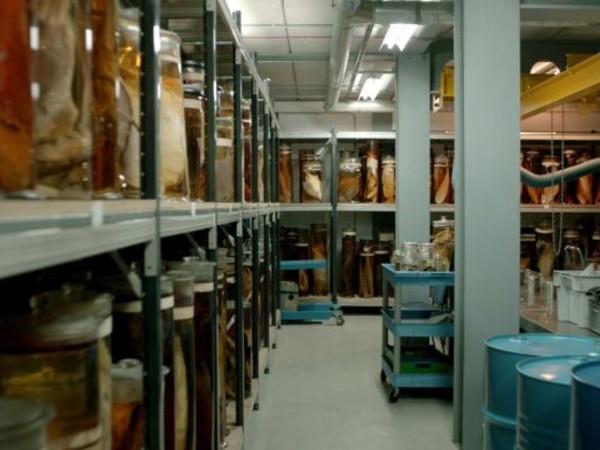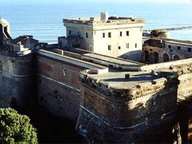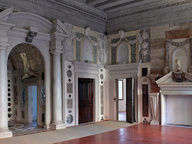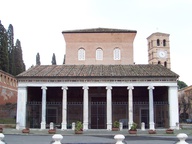Shezad Dawood. Leviathan

© Shezad Dawood / Season Two Ltd | Shezad Dawood, Leviathan, production stills 2016
From 07 Maggio 2017 to 24 Settembre 2017
Venice
Place: Palazzina Canonica / Fabbrica Fortuny
Address: Riva dei Sette Martiri 1364
Responsibles: Alfredo Cramerotti
Organizers:
- Fondazione Querini Stampalia
- Istituto di Scienze Marine (CNR-ISMAR)
- Fortuny
Official site: http://www.leviathan-cycle.com
Venice, 7th May 2017 – An exhibition of a new and ambitious body of work by artist Shezad Dawood opens today across two sites in Venice to coincide with the 57th Art Biennale. The show marks
the launch of Leviathan, a ten-part film cycle conceived and directed by Dawood that will unfold over the next three years.
The first two episodes of the film are presented alongside a new series of textile and sculptural works in the newly-restored Palazzina Canonica, the former headquarters of the Institute of Marine Sciences in Venice, which is opening to the public for the first time since the 1970’s.
The two-part exhibition also features a site-specific intervention in the historic Fortuny factory on the island of Giudecca.
Curated by Alfredo Cramerotti, Leviathan is presented by the Fondazione Querini Stampalia in collaboration with the Institute of Marine Sciences (CNR-ISMAR) and Fortuny. Following the launch in Venice, the project will embark on a three-year UK and international tour, culminating in a final presentation of all ten episodes in 2020.
Leviathan is set in an imaginary future whose inhabitants are the survivors of a cataclysmic solar event. Each episode is told from the point of view of a different character and follows them
as they drift across Europe, Asia and North Africa, encountering a series of idiosyncratic communities. Filming locations include the Institute of Marine Sciences’ oceanographic platform in the Adriatic Sea, the Natural History Museum in London and an abandoned island in the Venetian lagoon.
Leviathan is also being released as a series of written fictions on the project website.
The first two episodes are available online at www.leviathan-cycle.com.
Shezad Dawood says:
“This project was already underway before climate discourse went from the mainstream to
the marginal. But the key question then, as now, was how to make the science and the possible future awaiting us more accessible. I hope the collaborative enterprise that begins in Venice, informed by so many generously lending their time and expertise, goes some way towards doing that.”
Alfredo Cramerotti, Curator, says:
“Shezad Dawood’s artistic practice is becoming increasingly relevant and timely, within and beyond the art world. Fundamentally, it’s less about the what, and more about the why, and the how we come to terms with our present environment.”
Tania Doropoulos, Project Director and
Director of Exhibitions at Timothy Taylor, says: “We are very proud to be able to support such an ambitious project that not only confronts key issues of foremost global concern, but also resonates profoundly with Venice’s particular history.”
The exhibition in Venice is accompanied by a lively Public Programme that brings together specialists involved in the project for a series of informal discussions akin to the philosophical ‘agora’ in Ancient Greece.
In dialogue with a wide range of marine biologists, oceanographers, political scientists, neurologists and trauma specialists, Dawood has been exploring some key fault lines of the present and their possible interconnections. Taking a global and collective approach, Leviathan is
a reflection on where we could be if a deeper understanding of trauma and climate erosion
is not found, looking at what is not only a humanitarian crisis, but a wider crisis within
our biosphere.
The new series of textile paintings has been developed in dialogue with the renowned
textile manufacturer Fortuny, and incorporates several of their hand-made fabrics. Dawood
has furthermore been working closely with the Labanof in Milan, an institute that conducts research on personal effects lost by migrants during sea crossings to Lampedusa, in order to help families identify missing relatives. A series of artefacts and objects from the Labanof archive have provided the visual references for the new textile works.
The paintings are installed in the library of the Palazzina Canonica as well as in the showroom of the Fortuny factory in the Giudecca, established in 1919 and still operational today. In addition,
a large-scale outdoor neon work titled Island Pattern, developed especially for the Fortuny factory, occupies the garden façade of the building. The installation reflects the pattern of
a specific Fortuny design and at the same time parallels wave formations on the Venetian lagoon that are indicators of climate change and rising sea levels.
These discussions will also be available in digital form through the project’s web platform,
creating an archive aimed at scientists, researchers, students and the general public.
In addition, a special film programme curated by Shezad Dawood in collaboration with streaming platform MUBI will run throughout the duration of the exhibition, with free film screenings taking place at the Palazzina Canonica.
The third film episode will be shot on location in Venice and incorporated into the exhibition in September 2017. Subsequent episodes will be co-commissioned and presented in partnership with a series of international venues, culminating in the presentation of all ten episodes in 2020.
The project is being developed with the support of Timothy Taylor, Outset Contemporary
Art Fund, Galerie Gabriel Rolt, CREAM
- University of Westminster, University of Salford Art Collection with support from
The Contemporary Art Society, and a circle of Private Patrons.
SCARICA IL COMUNICATO IN PDF
COMMENTI

-
 Dal 31 gennaio 2024 al 04 maggio 2025
Fermo | Palazzo dei Priori
Dal 31 gennaio 2024 al 04 maggio 2025
Fermo | Palazzo dei Priori
-
 Dal 20 dicembre 2024 al 04 maggio 2025
Fermo | Palazzo dei Priori
Dal 20 dicembre 2024 al 04 maggio 2025
Fermo | Palazzo dei Priori
-
 Dal 20 dicembre 2024 al 04 maggio 2024
Gorizia | Palazzo Attems Petzenstein
Dal 20 dicembre 2024 al 04 maggio 2024
Gorizia | Palazzo Attems Petzenstein
-
 Dal 18 dicembre 2024 al 18 dicembre 2024
Venezia | Museo Correr
Dal 18 dicembre 2024 al 18 dicembre 2024
Venezia | Museo Correr
-
 Dal 14 dicembre 2024 al 02 marzo 2025
Palermo | Palazzo Abatellis
Dal 14 dicembre 2024 al 02 marzo 2025
Palermo | Palazzo Abatellis
-
 Dal 12 dicembre 2024 al 23 febbraio 2025
Roma | Palazzo Altemps
Dal 12 dicembre 2024 al 23 febbraio 2025
Roma | Palazzo Altemps


